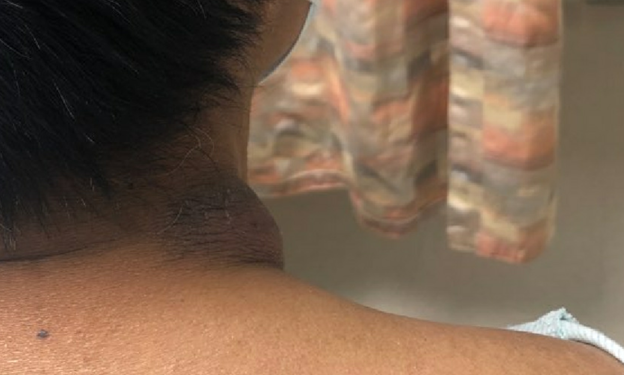Case Presentation: A 48-year-old male with a history of hypertension and type 2 diabetes was sent to the emergency department for a “prostate x-ray” by his primary care physician due to elevated creatinine, hyponatremia, and two-day history of gross hematuria. The patient denied dysuria, fevers, chills, night sweats, and cough. He did note weight loss over the past year but attributed it to food insecurity after losing his job. Though he had not recently traveled, he reported immigrating to Texas 7 years ago from Mexico.The patient was worked up for a postrenal acute kidney injury with a creatinine of 3.6 mg/dL. The last documented creatinine was 1.0 mg/dL five years prior. A bilateral renal ultrasound showed mild right hydronephrosis secondary to a mass or blood clot in the bladder and circumferential thickening of the bladder wall. Urinalysis showed sterile pyuria and urine cultures were negative. Upon further questioning, the patient disclosed that he had a rapidly growing right neck mass. Cervical CT scan showed a noncalcified mass in the right posterior cervical subcutaneous soft tissues. A right upper lobe consolidation and multiple bilateral foci of tree-in-bud opacities were found incidentally. Interventional radiology obtained a biopsy of the right neck mass: mycobacterial, bacterial, and fungal cultures, acid fast bacillus (AFB), and cytology all came back negative.Due to high clinical suspicion of tuberculosis (despite two preliminary negative AFBs from the neck mass biopsy), the patient underwent a bronchoscopy with bronchoalveolar lavage. QuantiFERON TB Gold and MTB Complex PCR Urine resulted positive. The patient was diagnosed with disseminated TB (urinary, pulmonary, and scrofula) and started on RIPE therapy. Urology was consulted to remove adhesions, urethral strictures, and relieve the bladder obstruction secondary to TB.
Discussion: In 2018, the incidence of tuberculosis in the US was less than 3 cases per 100,000 people [1]. Only 20% of these cases were extrapulmonary tuberculosis (EPTB) [2]. Urogenital tuberculosis is the third most common form of extrapulmonary TB behind lymphatic and pleural involvement. Diagnosis is often delayed due to a lack of systemic symptoms that are typically associated with TB. Pyuria and microscopic hematuria may be incidentally observed early in the disease course. More advanced disease presents with urinary frequency, dysuria, and urgency in half of cases while gross hematuria and low back pain develop in one-third of cases [3]. Unfortunately, the late onset of symptoms can delay diagnosis, leading to the development of cavities, strictures, and renal failure.We present a case of a patient who, despite having several manifestations of disseminated TB, had several negative cultures; pulmonary manifestations were found incidentally. The definitive diagnosis was made with urine PCR. Our patient was started on anti-tubercular treatment; however, he had already progressed to Stage 5 kidney disease. He was recommended to start hemodialysis.
Conclusions: The difficulty of the diagnosis in addition to the rarity of the condition in the US and the severity of a disseminated TB infection make this an important diagnosis to make. Urogenital tuberculosis has been widely studied, yet the nonspecific nature of its presentation often delays diagnosis. Though more than 90% of cases of genitourinary TB occur in developing countries, a high degree of suspicion should be exercised in patients that immigrated from endemic areas, are immunocompromised, or have been incarcerated [4].

